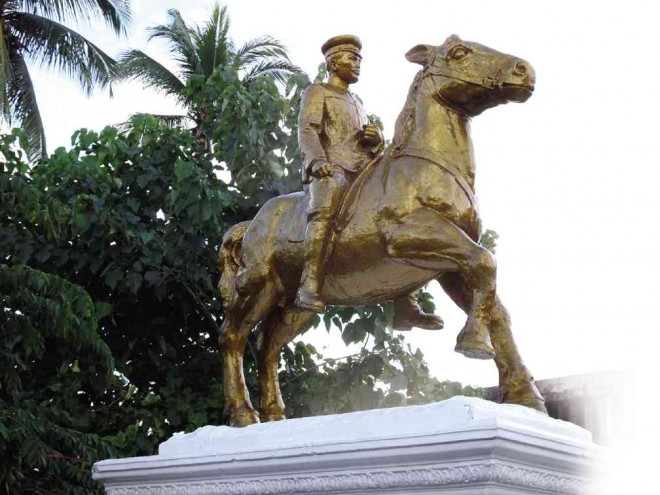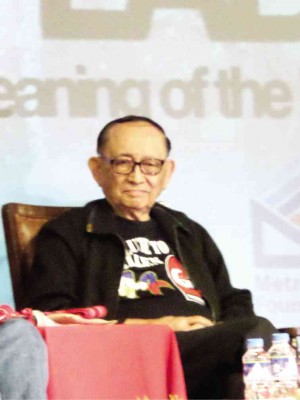Three films challenge the youth to do what’s right
With national elections coming up, some groups have launched their own campaigns to win the hearts and minds of Filipinos, particularly the young, not for any party or candidate but to inspire them to make the right choices and decisions for the country.
The commercially and critically successful ‘Heneral Luna’ movie set the backdrop for campaigns targeting mainly students.
Post-martial law babies and millennials might have failed to see the significance of the opening scene where Luna was telling his story to a young man named Joven (Spanish for young), but they did realize that Jerrold Tarog’s film about the tragic life of the Filipino revolutionary general was a mirror of the Filipinos’ faults and foibles, the characteristics that stunted nationhood.
National Artist and Ramon Magsaysay Award recipient Francisco Sionil Jose said, during a special screening of the film, that viewers would conclude, after watching ‘Heneral
Luna,’ that many of the things that happened to the country were ‘kasalanan natin lahat. In the end, it is our fault.’
The film should lead to some serious soul-searching, he said. ‘We should ask ourselves what is wrong with us.’
Filipinos are braggarts, ‘sobra ang yabang’ and very shallow, Sionil Jose said. Very shallow people want to be senators and President, he said, and just as shallow voters elect them to office.
But Sionil Jose said there were also several things going for the Philippinesóa revolutionary tradition and its being a young nation of young people, among other things. He pointed out that not one hero of the revolution was more than 40 years old.
The novelist said, ‘Our distinguishing value as a people, of which we can be proud of anytime, is we are heroic.’
Setting the record straight
That heroism, as well as the ability to rise above personal and familial interests and regional loyalties, is the focus of two documentary films, ‘Laban: The Meaning of the Edsa
Revolution’ and ‘Unsurrendered 2: The Hunters ROTC Guerrillas.’
Now making the rounds of campuses, the films aim to show young Filipinos that they are capable of putting country above self.
‘Laban,’ produced and directed by Sally Jo Bellosillo, is the centerpiece of an eight-month road show lecture series, ‘Edsa@30: How the Edsa People Power Revolution Transformed the Philippines,’ initiated by the Ramos Peace and Development Foundation (RPDEV) to mark the 30th year of the ouster of the dictator.
Launched at the Lyceum of the Philippines University (LPU), the campaign that continues until February and will cover 16 universities, including those in Bulacan, Nueva Ecija, Pangasinan, Cebu and Davao, seeks to inform and educate the youth about what really happened during martial law and the Edsa uprising, especially in the light of revisionist accounts that portray the years of dictatorship as a time when the Philippines enjoyed economic success, peace and order, and political stability.
Historian Dr. Vicky Narciso-Apuan of Miriam College, though speaking in a light-hearted manner, stressed why the dictatorship’s omissions and commissions could not be glossed overófrom the very serious imprisonment and enforced disappearances (many victims were never seen or heard from again) of government critics to the ludicrous ban on long hair for boys and men.
It was estimated, she said, that 80,000 people became political prisoners.
Narciso-Apuan said that, far from boosting the Philippine economy, martial law killed many businesses and enterprises. ‘Instead of being a producer, the Philippines became an importer of everything, including safety pins.’
Only the so-called ‘FM cronies’ófriends and associates of Ferdinand Marcosóprogressed, not the country, the history professor said.
She said it was not a ‘smiling martial law’ government, as revisionists would like the young to believe. Peace was the ‘peace of the grave,’ she said.
But while Edsa showed that Filipinos could unite and rise above themselves,
Narciso-Apuan stressed that it remained an unfinished revolution. She said there was so much that still needed to be done and the young could be heroes themselves by helping accomplish those things.
Panelist Maan Hontiveros, a major player in the takeover of the government television
station during Edsa, pointed out that the dictatorship had complete control of media
organizations, forestalling any criticism and ensuring that only glowing accounts of what the government was supposedly doing reached the public.
Hontiveros said that, even if only for the freedom to speak her mind, post-Edsa was still infinitely preferable to military rule.
Former Interior Secretary Rafael Alunan, another panelist, said Edsa gave Filipinos a chance to change, but lamented that they still had not learned to put the common good above self.
Citing Filipinos’ tendency toward individualism, RPDEV founder and former President Fidel V. Ramos urged LPU students and other young people to care, share and dare.
Ramos, who was also a panelist, said ‘caring and sharing were easy enough to doóFilipinos are like that, helpful, compassionate, even forgiving,’ but daring would require more.
‘Daring means giving. It means to give more than you take,’ he told the audience that included LPU president Roberto Laurel and vice president for finance Sallie Laurel-Lopez. ‘It means to sacrifice, to work in concert, in cooperation with others.’
The former President said the task of transformation and reform was unfinished. He said Filipinos needed unity, solidarity and team work.
Ramos, a relative of Marcos and who headed the Philippine Constabulary during martial law, helped spark the Edsa
People Power Revolution by withdrawing his support from the government.
The late Jaime Cardinal Sin mobilized ordinary citizens to converge on Edsa, in front of Camps Aguinaldo and Crame, to protect Ramos and then Defense Minister Juan Ponce
Enrile from government military forces.
Selfless youth
If ‘Laban’ proves that Filipinos can unite, even so briefly for a common cause, ‘Unsurrendered 2’ aims to inspire the young to love their country above all and show their capacity for selfless sacrifice for a lofty goal.
The documentary by Bani LogroÒo ‘celebrates the heroism of the Hunters ROTC’ who, in spite of their youth, fought in World War II for the country’s future, said Roberto F. de Ocampo, chair of the Philippine Veterans Bank (PVB), which is sponsoring the showing of the film in several schools.
The guerrilla group was composed of people mostly in their teens who, when schools were closed after the Japanese invasion of the Philippines, did not look at the protracted class suspension as a holiday but as an opportunity to do their bit for the war effort.
Hunters’ core group consisted of junior cadets from the Philippine Military Academy and members of the Reserved Officers Training Corps in various universities and colleges. Eventually it would count among its members children as young as 12, women and young adults.
De Ocampo said they wanted to show today’s youth the heights of heroism they could reach because they (sponsors) did not want to look back and see that all that valor displayed by the Hunters ROTC was in vain.
University of the Philippines history professor Ricardo Jose said that in the documentary, the Hunters showed that Filipinos could never be too young to do something for their country.
Lucky Guillermo, the film’s executive producer, said they planned to screen the movie in about 60 schools and universities so the youth would learn about and be inspired by the heroism and selflessness of the young people of another generation.

